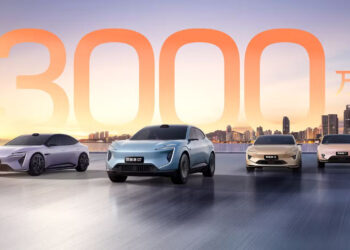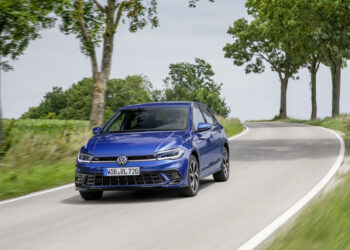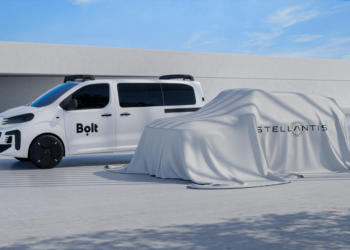Volkswagen is bringing a familiar name to Europe with the introduction of the Tayron, a model that has been a staple in the Chinese market since 2018. Now set to replace the Tiguan Allspace in Europe, the Tayron is essentially a stretched version of the latest-generation Tiguan, providing a new three-row option for compact SUV enthusiasts. The Tayron is also a preview of what American consumers can expect, as the next iteration of the Tiguan in the U.S. will mirror this seven-seat configuration.
Slotting between the Tiguan and the Touareg—which remains unavailable in the U.S.—the Tayron offers flexibility with both two-row and three-row configurations, much like VW’s Czech sibling, the Skoda Kodiaq. This larger SUV extends to 187.8 inches (4770 mm) in length, making it 9 inches (231 mm) longer than its Tiguan counterpart. Its wheelbase also grows by 4.5 inches (114 mm), reaching 109.8 inches (2791 mm), to comfortably accommodate a third row of seats. The Tayron measures 72.9 inches (1852 mm) in width and 65.3 inches (1660 mm) in height, slightly larger dimensions than those of the Tiguan.
Practicality Meets Versatility
With these adjustments, the Tayron emerges as a highly practical SUV. In its three-row configuration, it offers a modest 12.2 cubic feet (345 liters) of cargo space behind the seats, but for those opting for the two-row model, the space increases significantly to 31.2 cubic feet (885 liters). When the rear seats are folded down, the capacity jumps to 73.8 cubic feet (2,090 liters) for the two-row variant, while the three-row model offers up to 67.2 cubic feet (1,905 liters).
The plug-in hybrid (PHEV) variant—only available as a two-row model—has slightly less cargo space due to its battery pack. It provides 24.9 cubic feet (705 liters) with the rear seats upright and 67.6 cubic feet (1,915 liters) when folded flat.
Engine Options: From Gas to Hybrid
All versions of the Tayron are equipped with a dual-clutch automatic transmission—six gears for the hybrids and seven for the traditional gas and diesel models. The PHEVs, as well as the base gasoline and diesel models, are front-wheel-drive only. Entry-level models feature a 1.5-liter turbocharged gasoline engine producing 148 horsepower and 184 lb-ft (250 Nm) of torque. This engine incorporates mild-hybrid technology and has the capability to run on just two cylinders to conserve fuel when full power isn’t needed.
On the diesel front, Volkswagen offers a 2.0 TDI engine with the same 148 hp but a torque boost to 266 lb-ft (360 Nm). For those wanting more power, a higher-output 2.0 TDI variant with all-wheel drive delivers 201 hp and 295 lb-ft (400 Nm) of torque. Gasoline options include two 2.0 TSI engines: one generating 148 hp and 236 lb-ft (320 Nm), and another more powerful version offering 261 hp and 295 lb-ft (400 Nm).
A Shift Towards Electrification
In line with Europe’s increasing move away from diesel engines following the Dieselgate scandal, Volkswagen is also offering two PHEV models for the Tayron. These combine a 1.5-liter turbo gasoline engine with an electric motor to produce either 201 hp or 268 hp. Both versions share a 19.7 kWh lithium-ion battery pack, capable of DC fast charging at 50 kW. On a full charge, these hybrids boast an electric-only range of over 62 miles (100 kilometers). When combined with the gas tank, a Tayron eHybrid can cover an impressive 528 miles (850 kilometers).
More Features for Off-Road and Urban Adventures
To maintain its off-road capabilities, the Tayron has a waterproof structure protecting the hybrid battery, ensuring a fording depth of 27.5 inches (70 centimeters). The SUV also introduces the Overtrail trim, which features front and rear differential locks to complement the center lock, enhancing its rugged appeal. The Tayron Overtrail rides on either 18-inch all-terrain tires or mud/snow rubber, depending on the region.
Additional enhancements include stronger engine mounts to support the added hybrid components, a repositioned spare tire to accommodate the battery, and a more rigid radiator support. Inside, the Tayron offers a new 12.3-inch digital instrument cluster, redesigned seats, and fast-charging capabilities for the wireless pad. An Electro-Shiftmatic system, first seen in the Prius for its shift-by-wire technology, makes its debut in the Tayron, featuring an exclusive shift knob designed for ease of use.
Release and Pricing
The electrified Tayron and its various trims are set to roll out gradually, starting at the end of this year. While official pricing for the hybrid versions has yet to be disclosed, they are expected to command a premium over the current LX 600, which starts at $93,915 and can go up to $134,490 in the United States.
Volkswagen’s expansion of the Tayron into the European market and beyond indicates a broader strategy of offering versatile, electrified SUVs to cater to various consumer needs, bridging the gap between practicality and luxury.










